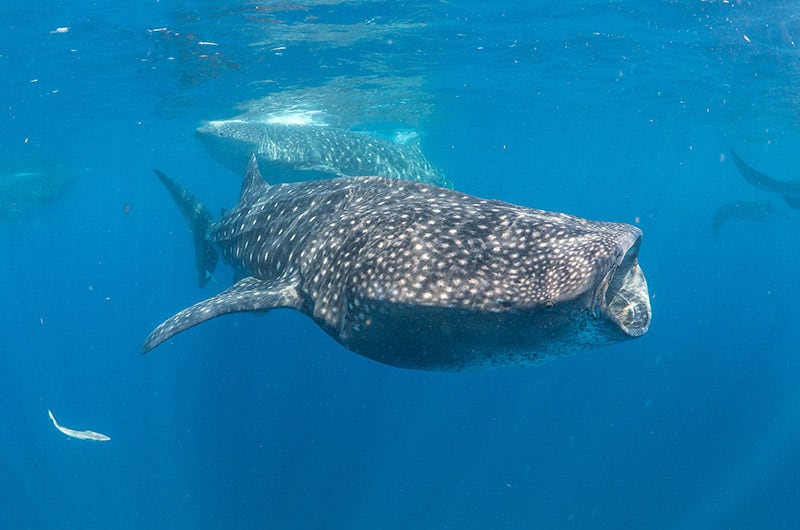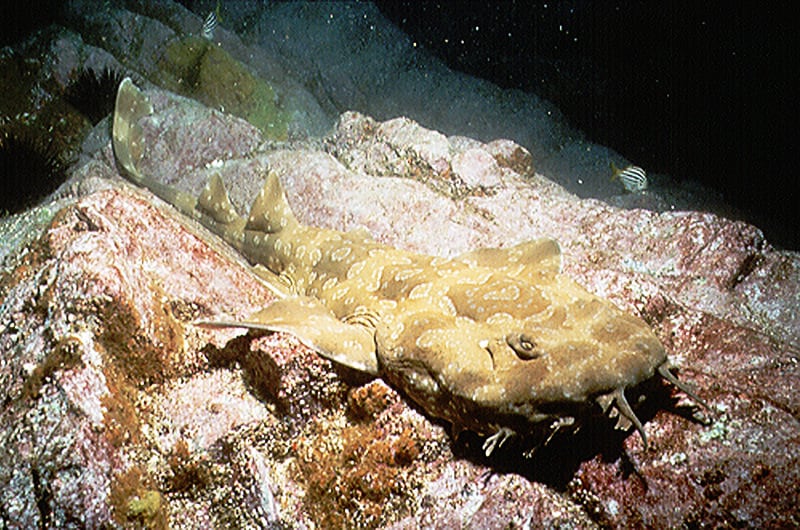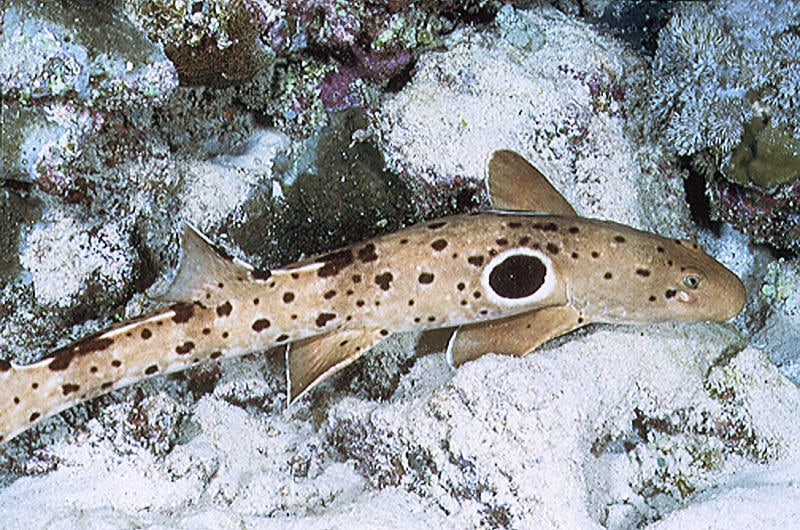Photo © Alexa Elliot
Photo © Alexa Elliot
Photo © Alexa Elliot

Typical species:
Whale shark
Photo © Simon Pierce
Families:
7
Genera:
13
Species:
45
Carpet sharks
This order represents a very diverse group with respect to size and shapes. It consists of 7 families and 13 genera comprising approx. 34 species. Assorted members of this group include such different forms as whale sharks, nurse sharks, wobbegongs and zebra sharks. They primarily live in the shallow tropical waters of the Indo- and Westpacific region.
Carpet sharks have barbels and spiracles. Spiracles are openings located behind their eyes and are used to suck in sediment free water from above the ground.

Typical species:
Nurse shark
Photo © BluePlanetArchive.com
Nurse sharks
This family consists of 3 species, separated in 3 genera. All have small transverse mouths in front of their eyes and short to long barbels. The position of the spiracles is behind the eyes and not below. Both dorsal fins are either of equal size or the first one can be slightly bigger. The origin of the first dorsal fin is slightly anterior or over the bases of the pelvic fins. The second dorsal fin is in front of the origin of the anal fin. Nurse sharks are very common in tropical and subtropical waters world-wide over the continental and insular shelves, from intertidal regions down to about 70 m . Nurse sharks prefer rocky or sandy bottom, or coral reefs, or even mangrove areas. They can often be found in aggregations while resting on the bottom. They feed on bony fishes, crabs, molluscs, corals and even sea urchins. Nurse sharks possess either an ovoviviparous (aplacental viviparous) or oviparous (egg laying) style of reproduction.

Typical species:
Whale shark
Photo © Simon Pierce
Whale sharks
Whale sharks are the worlds biggest fish-like animals, reaching sizes up to 14m. Only one species is known, Rhiniodon typus. Whale sharks are unmistakable. They have a very big, broad and flattened head and huge transverse and terminal mouth with very small barbels. The eyes are on the sides of the head with small spiracles directly behind. The gill slits are very large with the fifth one well separated from the fourth. The first dorsal fin is much larger than the second. The origin of the first dorsal fin is well anterior to the pelvic fins' origins. Whale sharks possess three prominent ridges along the abdomen with the lowermost expanding into a prominent keel on the side of the peduncle. They are circumglobal in tropical and warm temperate waters, preferring surface waters. Whale sharks are plankton feeders. Contrary to basking sharks, whales sharks actively suck in the water. They have an oviviviparous style of reproduction (aplacental viviparity).

Typical species:
Zebra shark
Photo © Jeremy Safford-Deitsch
Zebra sharks
Only one species represents this family, the zebra shark, Stegostoma tigrinum. Zebra sharks can only be found in the Indo-West Pacific area, from the Red Sea down to Australia. The body is unique: long, with a tail that is a long as the body, small transverse mouth in front of the lateral eyes; and two spineless dorsal fins and very prominent ridges on the side of the body. Adults have a yellow coloration with dark spots over the entire body, juveniles are dark brown with yellow stripes. Zebra sharks prefer coral reefs, and sandy bottoms. Although quite common, their biology is still poorly known. They are apparently rather sluggish, at least during daytime. Their flexible body allows them to search for food such as molluscs, crabs and small fishes in crevices and narrow cracks. Zebra sharks lay eggs (oviparity).

Typical species:
Blind shark
Photo © Marinethemes.com
Blind sharks
This family consists only of 2 species. Their appearance resembles nurse sharks. Barbels are present with a small transverse mouth in front of the eyes. Their heads are broad and somewhat flattened with very large spiracles. Blind sharks are common, small and harmless sharks of temperate and tropical waters around Australia. They live on the bottom over the continental shelf from the intertidal zone down to about 100 m and can sometimes be found in water depths that barely covers them. They prefer rocky or coral areas. At least one of the two species is aplacental viviparous (ovoviviparous). Blind sharks feed on small fishes, crustaceans and sea anemones. Their common name derives from the fact that the species Brachaelurus waddi closes its eyes when removed from the water.

Typical species:
Spotted wobbegong
Photo © Doug Perrine
Wobbegongs
All 6 species of this family have a very distinctive flattened body and possess narrow dermal flaps along the sides of their heads. Large spiracles are present, of a size that is bigger than the eyes. Both dorsal fins are of equal size. The origin of the first one is over or slightly behind the insertion of the pelvic fins. All members of this family possess fang-like teeth, 3 rows close to the symphysis of the upper jaw and two rows in the lower jaw. All wobbegongs are relatively common in temperate and tropical continental waters of the western Pacific, occurring from very shallow water down to about 100 m. Wobbegongs prefer sandy or rocky bottoms, or coral reefs and can be found laying on the bottom, like nurse sharks. However, with their lateral skin flaps along the side of their heads and their coloration they are often difficult to spot against the bottom. They have an ovoviviparous style of reproduction (aplacental viviparity). They are very powerful predators and can reach large sizes, up to 3.7m. Their camouflage, big jaws and size makes them potentially dangerous, although not aggressive unless provoked.

Typical species:
Epaulette shark
Photo © BluePlanetArchive.com
Bamboosharks
This family consists of 11 species, separated in 2 genera. All members have an elongated, slightly depressed or cylindrical body. Short barbels are present. The mouth is small, transverse and located in front of the eyes. The spiracles are large and below their eyes. There are no spines in front of the two dorsal fins. The origin of the first dorsal fin is above or behind the pelvic fins. The origin of the second dorsal fin is well ahead of the anal fin's origin. Some of them have a well developed color pattern with dark sattles, or dark and light spots, while others are plain colored. Bamboo sharks are common inshore sharks of the continental waters of the tropical western Pacific. They prefer rocky areas or coral reefs close to shore and sometimes even invade tide pools where the water is barely sufficient to cover them. They feed on small fishes and invertebrates. Their reproduction style is not fully examined yet, however at least some of them are lay eggs (oviparity).

Typical species:
Collared carpetshark
Photo © Marinethemes.com
Collared carpetsharks
Collared carpet sharks are small and bear a slight resemblance to the cat sharks with their cat-like eyes. The mouth, however, is entirely in front of the eyes. The body is cylindrical or slightly depressed and elongated. The origin of the first dorsal fin is behind the bases of the pelvic fins. The biology of these species is only partially understood. They are mainly bottom dwellers and can be found from close inshore to depths of at least 180 m . They are found on muddy, sandy or rocky bottom, and are apparently able to change their colors somewhat to match bottom types. It is known that some of the species are oviparous and deposit eggs in elongated, flattened egg cases.